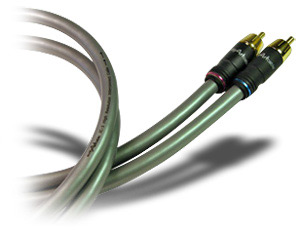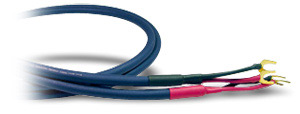![[SoundStage!]](../titles/sslogo3.gif) Home
Audio Home
Audio Equipment Review |
|||||||||||||||||
February 2006 Audio Art Cable IC-3 Interconnects and SC-5 Speaker Cablesby Sid Vootla
Evaluating interconnects and speaker cables is always a challenge due to the fact that they are supposed to transmit the signal from one component to another and not have a sound of their own. They should be neutral and faithfully transmit the signal fed to them, although this does not happen in every case. A cable can -- and many times does -- impose its own idiosyncrasies on the signal, thus compromising the sound. So a reviewer has to try and distinguish between a known pristine signal and any addition or deletion the cable is making. The only way to determine this is by listening and comparing, comparing and listening. A quick survey of current cables reveals that to transfer the signal one could spend a small fortune on esoteric designs that utilize exotic materials. The subjects of this review are more reasonably priced ways to connect your equipment, ones that would not result in taking out a second mortgage. Audio Art Cable is a new company started by Robert Fritz, who has 27 years of experience in audio as a sales professional and a custom-install specialist. His goal, to put it in his own words, is "offering a product with reference-quality audiophile sonic properties at a price that anyone looking for an upgraded cable could happily afford." To achieve this noble endeavor, he enlisted the design expertise of Darren Hovsepian of DH Labs fame. In order to maintain his prices in the "audiophile on a budget" realm, Fritz contracted with an offshore supplier in Taiwan to supply samples. He solicited feedback of these cables from experienced beta testers, and upon receiving favorable feedback from this group, he established Audio Art Cable early last year. In order to decrease costs further, he chose the online-retailer model that has helped many a successful business reduce overhead costs. Audio Art Cable offers a 30-day money-back satisfaction guarantee and a one-year warranty covering any and all manufacturing defects -- a win-win scenario to say the least. The current Audio Art product range comprises two interconnects and one speaker cable. The IC-1 copper stranded interconnect costs $45 USD per meter pair, the IC-3 silver/copper interconnect is available for $89 per meter pair, and the SC-5 silver/copper speaker cable costs $89 per eight-foot pair. While Audio Art sent me all three products, the latter two are the focus of this review. As the literature that came along with the cables explains, the IC-3 features silver-coated oxygen-free high-conductivity (OFHC) copper conductors in twisted-pair geometry that are 100% shielded with an aluminum Mylar shield to reject noise. The cross-section of the cable shows the two conductors along with a filler and a drain wire. The ultra-low-loss foamed polyethylene dielectric insulating the conductors provides very low capacitance of 30pF per foot and resistance of 0.009 ohm per foot. The RCA connectors are custom machined to a high quality; they gripped the jacks of my amplifier and preamplifier very firmly. DH Labs XLR connectors can be substituted as an option. The outer PVC jacket is silver in color.
The SC-5 is a very unassuming-looking 14-gauge speaker cable that consists of 168 strands of silver-coated OFHC copper insulated in a high-quality polyethylene dielectric. The manufacturer claims that the cable exhibits very low inductance and capacitance, making it suitable for all types of amps and speakers. The capacitance measures at 19.5pF per foot, and resistance is 0.0025 ohm per foot. The cross-section reveals two insulated conductors, vibration-absorbing fillers, and an outer PVC jacket. The SC-5 has a fairly attractive appearance with its dark-blue outer jacket and is easy to handle and connect to equipment because of its flexible nature. Review system My reference system consists of a Sunfire Classic tube preamp and the excellent Quicksilver Mid Mono amplifiers, which together provide a smooth, warm sound to B&W Nautilus 805 speakers. Digital-source duties are handled by a Marantz SA-8620 CD/SACD player, which feeds a Musical Fidelity A324 upsampling DAC for CD playback. Analog is courtesy of a Music Hall MMF-7 turntable with Goldring Eroica cartridge, and a Creek OBH-15 phono stage. Robert Fritz recommends 100 hours of burn-in for IC-3 and SC-5, and I faithfully followed his advice. Listening Used in my system, the IC-3/SC-5 combination produced an extremely pleasing sound right off the bat: airy highs, precise imaging, and an expansive soundstage. The treble was smooth and did not produce any fatigue, even over extended listening sessions. I cued up Jack Johnson’s new CD In Between Dreams [Bushfire Records 0249880033]. "Banana Pancakes" highlighted the fine detail retrieval of these cables. On the opening notes of this track, Johnson is playing guitar slightly off to the left rear of the stage, while rain gently falls to the right. All of this could be heard very clearly, and I could even make out individual raindrops splashing. On a lesser system, this ambient rain would sound like static or hiss, but it was clear and distinct here. I use minimonitors in my system due to the small size of my listening room, so lower bass, or a lack thereof, is something of which I am very aware. Fortunately, much of the music I listen to is classic jazz, so the lack of the lowest octaves does not intrude upon my enjoyment. Still, I was not prepared for the extended lows that this cable combination brought forth. Listening to Patricia Barber’s Verse [Blue Note 2435-39856-2], especially "Pieces," I heard the staccato-like drum beats of Joey Baron fill my room with real authority. The bass was taut and well defined, and I could distinctly make out the percussive beats of the kick drum. There was absolutely no bloat; at such times I never feel the need to add a subwoofer -- I would never be able to integrate it so well into the system. My small room affords me the luxury of nearfield listening, which helps me hear deeply into the soundstage and locate the positions of instruments and vocals. My speakers are placed approximately six and half feet from my listening position, and consequently I can tell more often than not when a component detracts from the soundstaging ability quite easily. With the Audio Art Cables in the system, soundstaging was greatly enhanced. When I played the second cut, "Resolution," from John Coltrane’s A Love Supreme [Impulse 0249801092], the four artists were arrayed across the soundstage, with Coltrane’s sax to the left, McCoy Turner’s piano slightly forward and right of center, Jimmy Garrison on bass to the behind and right, and finally Elvin Jones on drums to the right rear of the stage. Considering that the original session was recorded in 1964, the fullness of the recording and the space that each instrument occupied in the stage were nicely defined. I am not certain whether this was a mono master adapted to stereo, but the soundstage was nicely arrayed and believable. The images that these cables presented never felt overly etched, but they were carved enough out of the space around them to be credible. Another favorite track of mine is "Tom’s Diner," from Suzanne Vega’s Solitude Standing [A&M Records 7502-15136-2]. I find this track very useful for discerning subtle differences when evaluating equipment because it is stripped of any accompanying instruments and just consists of Vega’s vocals recited almost in the form of a poem. Whenever I play this track on my system, I can almost feel the singer’s presence in my room. It's as if she is standing in the space between my speakers. With the Audio Art Cables in my system, I am happy to report that this illusion persisted with the same naturalness and eerie presence. Every pause and intake of breath was clearly pronounced, as they would be if someone were singing live in my room. Another feature that was highlighted while listening to this track was the neutrality of these cables. I could not make out any changes to the character of the singer’s voice. I was particularly wary about the addition of sibilance. Fortunately, Suzanne Vega's voice sounded exactly the same as I have heard it on many different occasions with other higher-priced cables in my system. Comparison I compared the SC-5 speaker cables with a similarly priced speaker cable that I had on hand, the highly regarded Ultra from Signal Cable, which has an Internet-direct price of $109 per six-foot pair. I removed the SC-5 and added the 10-gauge Ultra to my system and noticed right away that there was a slight reduction in overall resolution and airiness. On the other end of the spectrum, the bass with the Signal Cable had a tad more extension than what I had heard with the SC-5s. I then compared the Audio Art IC-3s to Outlaw Audio’s PCA interconnects, which are also sold direct and cost $49.95 per 1.2-meter length. In almost all areas, the IC-3s outgunned the PCAs. Bass was tighter and more extended, resolution was superior, and imaging and soundstaging were more precise. With every song I played I could hear the differences with the PCAs in place. The only area in which the PCA has an advantage is the way in which it makes a connection, via a threaded, locking RCA connector. Once the connector is tightened, only an earthquake can involuntarily shake it loose. Overall, I preferred the SC-5 and IC-3 to the Signal Cable and Outlaw Audio products. Luckily you can try all of these products and choose the ones you like best. All are sold direct and come with satisfaction guarantees, so determining preference is a simple matter of testing them in your system and making an informed choice all in the comfort of your home. If you decide that one or another is not for you, all you are out is a nominal shipping charge. Conclusion Has Robert Fritz achieved his goal of offering a product with reference-quality "audiophile" sonic properties at an affordable price? The answer is a resounding "Yes." In the weeks that I spent with these cables, I came to love their sound, which allowed me to hear more deeply into each recording. The SC-5 and IC-3 excel at soundstaging and imaging. They sounded very smooth and non-fatiguing, had excellent detail retrieval, and at the same time managed to get out of the way and let the music flow through. No part of the frequency spectrum was unduly emphasized or attenuated, which I feel is a very important characteristic of any cable. I particularly recommend the IC-3 interconnect and advise you to check it out before you buy any higher-priced competitor. You will be pleasantly surprised by the musical performance that can be had from such a reasonably priced interconnect. ...Sid Vootla
|
|||||||||||||||||
|
|||||||||||||||||
![[SoundStage!]](../titles/sslogo3.gif) All
Contents All
ContentsCopyright © 2006 SoundStage! All Rights Reserved |

